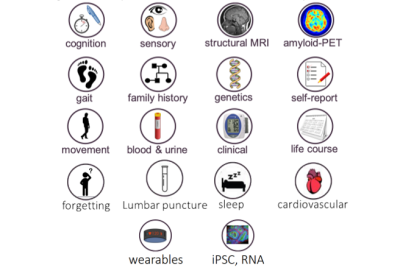
The Medical Research Council National Survey of Health and Development (NSHD; also known as the British 1946 Birth Cohort) is one of the oldest continuously running birth cohorts. The cohort comprises 5362 individuals born in England, Scotland, and Wales in one week in March 1946.
Data has been collected on the individuals at 26 time points, as well as through smaller sub-group collections. As of January 2020, approximately 2,600 study members remain in active follow-up. This cohort is particularly interesting and unique because health and life circumstances, and cognitive and physical measurements have been collected on this group since their childhood, allowing scientists to identify social and biological factors that affect lifelong health, ageing, and the development of chronic disease.
Insight 46 is a neuroimaging sub-study of the NSHD. Beginning in 2015, 502 NSHD members were recruited to take part in a clinic visit to London at two time points (Phases 1 and 2). The study was expanded in 2021 to increase the sample size and to bring some participants to London for a third time point (Phase 3). The picture below is a depiction of the types of data collected during the multi-day clinic visits, and more detailed information about the research can be found in the extensive Insight 46 publication list.

Click on the links on the left-hand side of the page to learn more about Insight 46, the team, and the research.
If you are a member of the NSHD or if you are interested in learning more about the 1946 British birth cohort life course data, please click here to visit the webpage for the NSHD.
- Links
- Insight 46 is a Data Partner with the Global Alzheimer's Association Interactive Network (GAAIN)
- More information about the NSHD cohort
- Alzheimer’s Research UK (ARUK) Overview of Insight 46
- Dementias Platform UK (DPUK) Final Report for Insight 46
- Insight 46 Funders
Phases 1 and 2 of Insight 46 were principally funded by grants from:
Alzheimer’s Research UK (ARUK-PG2014-1946, ARUK-PG2017-1946 PIs Schott, Fox, Richards),
The Wolfson Foundation (PR/ylr/18575 PIs Fox, Schott), and
The Medical Research Council Dementias Platform UK (CSUB19166 PIs Schott, Fox, Richards).
Phase 3 of Insight 46 is principally funded by:
Alzheimer’s Association (SG-666374-UK BIRTH COHORT PI Schott).
Additional funding to support Insight 46 data collection and analyses has been provided through grants from:
The Medical Research Council (MC_UU_00019/1 PI Chaturvedi and MC_UU_00019/3 PI Richards),
The Wellcome Trust (Clinical Research Fellowship 200109/Z/15/Z, Parker),
Guarantors of Brain (Brain ‘Entry’ Clinical Fellowship, King-Robson),
The Galen and Hilary Weston Foundation (UB170045 PI Schott),
Brain Research UK (UCC14191, PI Schott), and
AVID Radiopharmaceuticals (a wholly owned subsidiary of Eli Lilly) provided the [18F]florbetapir Aβ PET tracer in kind during phases 1 and 2. Life Molecular Imaging, part of Life Healthcare’s Alliance Medical, provide the [18F]florbetaben Aβ PET tracer in kind during phase 3. Neither AVID Radiopharmaceuticals nor Life Molecular Imaging had any part in the design of the study.
 Close
Close

